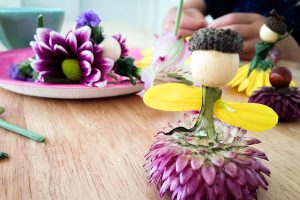This blog entry is a repost of an article I wrote, which was published in Grounded Magazine in their Autumn 2014 "Make" issue. I'm revisiting it on this Spring Sunday morning, as I listen to my now 3rd grade daughter in her singer-songwriter creative zone in the other room. Unfortunately Grounded Magazine is no longer being published, and I wanted this piece to live on, so I will share it here with you. Wishing a spacious and creative day to you and yours!
My second grader and I linger at the table after breakfast on a brisk Autumn morning. I sip my light and sweet slow-drip and watch my mind fill with a Sunday to-do list: return emails, grocery shop, send birthday card. Out of the corner of my eye, I catch a twirl of our handmade driftwood mobile near the window. For the next few moments, my thoughts flip-flop between warm days along the coast and plans to pick up butter and stamps.
Meanwhile, my daughter is grabbing a jar from a nearby shelf and is intensely engaged with acorn caps she collected on a walk yesterday. With profound focus, she is stacking them, lining them up, closely studying their shape and texture. She perches one between her thumb and pointer finger, declaring, “A perfect size for a fairy hat! Hey Mom, let’s make flower fairies!” Her proposal abruptly snaps me right back into the present moment, waking me from nostalgia for days passed and plans for the day ahead. One of the most profound gifts our children offer is reminding us to return to the present moment.
“Let’s make flower fairies!” is my daughter’s way of inviting me to enter her world of imaginal play and creation. She wants to connect in the most natural way children know – through immersion in the flow of creative expression. It’s so sincere and beautiful, and my iPhone is buzzing and there are dishes from breakfast and wet clothes to be dried and.. and.. and…
As both a mother and a mindfulness-oriented art psychotherapist, I have learned the deep, lasting, and mutual benefits of making art alongside our children. I can say, from personal and professional experience, this practice is not easy in modern parenthood. When we sit down to draw with our children, it’s either the ding of our inbox or the relentless voice of the inner critic distracting us from true absorption in the activity.
Slowing Down
A creative home life requires making mental space and time much more than it demands an expertly appointed craft room. Cuddling on the couch with a bag of seashell souvenirs and a spool of yarn from the junk drawer to create a garland will be meaningful as long as we are able to be fully present in those moments. Our undivided attention is what fills children up most. The added benefit is that if we really show up, it can be deeply gratifying for parents, too.
The best way I know how to enter into creative space with children is to slow everything down. Slowness is the antidote for the modern din, like an inverse yoga pose to balance all the rushing around. We can use the slow pace of the natural world as inspiration for the rhythm of our creative home lives. Step out for a family walk to absorb the colors, light, and offerings of each season, opening all senses to the experience.
Dancing with the earth models deep, meaningful living for children, reaffirming that each beautiful detail is worth honoring. When we experience the world through a child’s perspective, we are able to tune into the hundreds of colors on the skin of an apple. We can recall the magic of watching yellow and blue paint mixed to a vibrant green for the very first time. Slowing down each step validates a child’s inborn need to investigate the process. In preserving this innate gift, we challenge our own glorification of efficiency and multitasking. Bringing mindfulness to our experiences heightens the ordinary into something extraordinary. It allows space for us to feel something and to respond to it. This is what art is meant to do.
Making is our birthright as human beings. Children are aware of their inherent ability to create and are visibly enthusiastic about the life-affirming magic of putting something new into the world. Often adults have abandoned our inner makers for more socially sanctioned pursuits. The gabby inner art critic we carry can rest when we dive into a project with our children because they don’t expect us to be Martha Stewart or Wayne Thiebaud. Above all, they want to connect with our smiling eyes and benefit from seeing our committed engagement with the creative process.
Setting the table
Art materials are food for the soul. When preparing a creative activity, whether for my art therapy adult clients or for my young daughter, I imagine I’m hosting a special dinner party with an intention of making my guests feel cherished. Much like a chef pairs specific flavors so as not to clutter the palette and overwhelm the senses, I edit the selection of materials. The menu varies, but the setting is always deliberate and the meal nourishing.
I prepare the space with intentions of simplicity, beauty, and rhythm. I let in natural light and fresh air, assessing the space for distractions that could pull my family away from creative absorption. I turn off and cover electronic screens. I sweep away clutter that interrupts the eye. If I’m distracted by the worry that the “meal” will be messy, I simply cover the floor with an drop cloth, put butcher paper or oilcloth over the table, and we don smocks. If I still find mess to be an obstacle, I don’t cancel the party; we dine al fresco instead.
Just as I would select food at the market for dinner, I incorporate natural materials that are local and in season into our buffet of creative offerings. This reinforces a child’s attunement with the rhythms of the earth and helps parents come back home to these inner movements of the soul. Natural objects account for half of the “art materials” in my home. We gather acorns, sticks, shells, stones, leaves, flowers, and pine cones and store them in large, clear jars on a dedicated shelf.
Rather than a huge collection of art supplies, I invest in fewer, high-quality materials that promise a powerful sensory experience. Aside from basic paintbrushes, scissors, and glue, a few of my favorite art media are Stockmar beeswax crayons, liquid watercolors, Lyra Ferby colored pencils, wool roving, a variety of yarn and string, and white paper (140 lb. for painting and 80 lb. for drawing.) Knowing each type of art media holds an inherent metaphor, from the yielding way watercolors blend together to the resistance of a sharp pencil on paper, I purposefully select materials that will help balance the current mood.
Combining earthy items with traditional art materials makes for an elegant creative provocation — an art invitation without the intention of a specific product, inviting experimentation and free self-expression. I sometimes set up a provocation before my daughter comes home from school or prepare it before bed, so it greets us in the morning. Some favorite pairings on our art table that offer limitless possibility are:
- leaves + clay
- driftwood + acrylic paint
- smooth stones + ink
- acorn caps + wool roving
- twigs + yarn
- flower petals + clear contact paper
- pine cones + colorful pompoms
- a wildflower bouquet + colored pencils
Trusting the process
Children feel held when there is rhythm and appreciate a time each day or week devoted to making. Co-creating a ritual to mark creative time as sacred will bracket the experience as heightened and special, like lighting a candle or ringing a bell to begin and end art sessions.
Embracing an experimental mindset when making with children helps us to honor the process. This doesn’t always mean letting go of the idea that we might create a product or a useful craft; rather, it allows for meandering, messes, and mistakes along the journey. I trust that the art materials will tell us which way to turn next, and I listen to them with focus and wonder so my daughter might do the same.
Like all cycles, each creative process winds down to completion. Together, we clean our materials with respect and care. We set aside time to reflect upon what we have made, as this part of the creative process allows for integration and meaning-making. A child’s art holds his or her stories, emotions, worldview, and self-concept, so we treat the art with the same respect as the artist. I withhold my opinions and projections, being responsible to ask my daughter open-ended questions about her process and her creation.
When the candle had been snuffed or the bell has been rung, my daughter is often recharged and seamlessly moves into solitary play. My to-do list is still waiting there for me, and I face it feeling more balanced, satisfied, and connected. In my maker-momma bones and my art therapist heart, I have intimately come to know the value of mindfully making creative space where flower fairies can fly.














